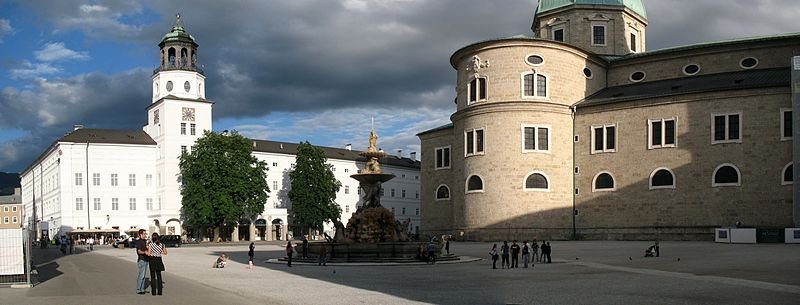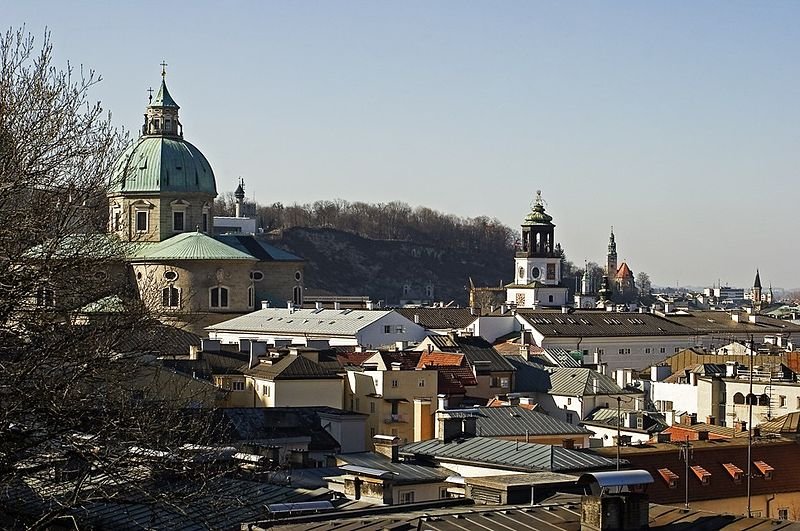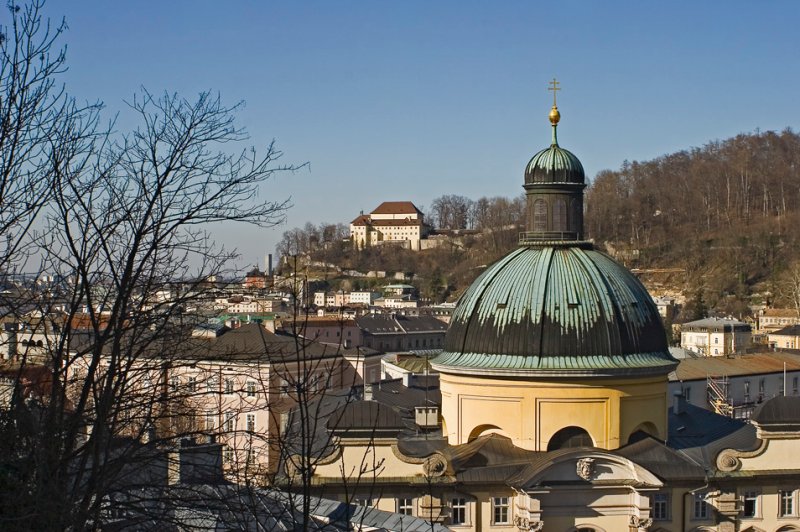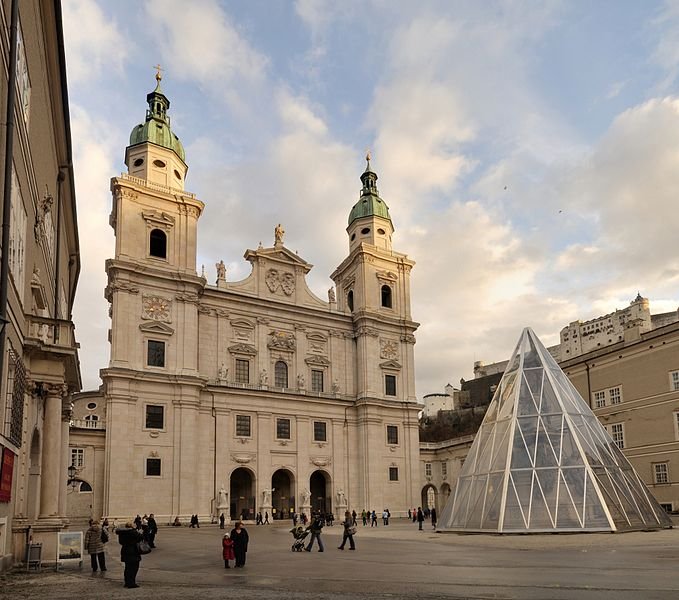 Residenzplatz in Salzburg, Austria, with view of the Glockenspiel and Cathedral
Residenzplatz in Salzburg, Austria, with view of the Glockenspiel and CathedralSource: https://commons.wikimedia.org/wiki/File:2047-2048a_-_Salzburg_-_Residenzplatz_-_Glockenspiel_und_Dom.jpg
Author: Andrew Bossi

Salzburg is a city in Austria long associated by the 18th century composer Wolfgang Amadeus Mozart. Since the mid 20th century, it has also become synonymous with Rodgers and Hammerstein musical, The Sound of Music, which features many of the sights in the city. The well-preserved historic center of Salzburg is today a World Heritage Site.
Salzburg is located on the banks of the Salzach River, close to the boundary with Germany. It is about 150 km to the east of Munich and 300 km to the west of Vienna. It covers 65 sq km (25 sq mi), on an average elevation of 424 m (1,391 ft). The city has a population of 148,000 (2011 estimate). It is the fourth most populous city in Austria after Vienna, Graz and Linz.
 The view of Salzburg Old Town as seen from Mönchsberg
The view of Salzburg Old Town as seen from MönchsbergSource: https://commons.wikimedia.org/wiki/File:Salzburg_-_Altstadt_vom_M%C3%B6nchsberg.jpg
Author: Pallasathena

Salzburg experiences a Continental climate. The warmest month here is July, when the average temperature rises to 24.4°C (75.9°F). It is also the wettest month, with 157 mm (6.2 in) of precipitation. Coldest month is January, when it drops to -4°C (24.8°F). Some snowfall can be expected between December and March.
Human settlement in the Salzburg area has been traced to the Neolithic Age, with evidence of Celtic settlements in the 5th century BC. The Romans merged the disparate settlements in the area in 15 BC to create the city of Juvavum, which was given municipium status in AD 45. The present city dates to around AD 700, when Saint Rupert was made the local bishop. He renamed Juvavum as Salzburg.
Religious conflict between the Catholics and Protestants was to rear its head in 1731, on the 214th anniversary of Martin Luther's nailing of his 95 Thesis on the Wittenberg School door, when the Roman Catholic Archbishop of Salzburg signed the Edict of Expulsion, forcing all Protestants to either recant their non-Catholic faith or else be banished from the city.
 View of Kajetanerkirche in Salzburg, as seen from Nonnberg
View of Kajetanerkirche in Salzburg, as seen from NonnbergSource: https://commons.wikimedia.org/wiki/File:Salzburg_-_Kajetanerkirche_vom_Nonnberg.jpg
Author: Pallasathena

Protestant landowners were forced to sell their land and livestock were dumped on the market. The Catholic archbishop also confiscated long belonging to Protestants for his own family, and ordered the Protestant books and Bibles burned. What followed was an exodus of Protestants to the cities in Germany controlled by Protestant princes. Many of the Protestants resettled in East Prussia as well as in present-day Slovakia, Serbia, Hungary, Berlin, Hanover, the Netherlands and some emigrated to Georgia in the United States.
Salzburg came under Bavarian rule in 1809, remaining so until the Congress of Vienna in 1815, when it was restored to Austrian rule. It became part of Austria-Hungary in 1866, then as part of German Austria in 1918, the First Austrian Republic in 1919, and the German Third Reich, when when Austria was annexed into Nazi Germany in 1938. Following the war, Salzburg was made the capital of the State of Salzburg, and remains to until today.
 The front courtyard of Salzburg Cathedral with a pyramid structure reminiscent of that at the Louvre
The front courtyard of Salzburg Cathedral with a pyramid structure reminiscent of that at the LouvreSource: https://commons.wikimedia.org/wiki/File:Salzburg_-_Salzburger_Dom3.jpg
Author: Taxiarchos228

Historic Centre of the City of Salzburg
The historic centre of Salzburg was inscribed as a World Heritage Site during the 20th session of the World Heritage Committee, which met in Merida, Mexico on 2-7 December, 1996. The heritage core zone covers an area of 236 hectares (see red boundary on map), bounded by a buffer zone of 467 hectares (green boundary on map).Salzburg World Heritage Site Inscription Details
Location: N 47 48 2 E 13 2 36Inscription Year: 1996
Type of Site: Cultural
Inscription Criteria: II, IV, VI
What to See in Altstadt Salzburg
There's plenty to see. To provide you with a detailed description, I am listing them all in alphabetical order. Please click in for details.- Festung Hohensalzburg (Hohensalzburg Fortress)
- Franziskanerkirche
- Getreidegasse
- Grosses Festspielhaus
- Haus der Natur
- Kapitelplatz
- Kapuzinerberg
- Kollegienkirche
- Makartplatz
- Mozarteum
- Mozarts Geburtshaus
- Nonnberg Abbey (Stift Nonnberg)
- Residenz
- Salzburg Cathedral (Salzburger Dom)
- Salzburg Museum
- Schloß Mirabell
- St. Peter Cemetery (Petersfriedhof)
- St Peter Abbey (Stift St Peter)
Visiting Salzburg
The Salzburg W.A. Mozard International Airport is located about 20 minutes from the city center. It receives flights from major cities in Europe. There is a trolley bus service from the airport to the city. Latest updates on Penang Travel Tips
Latest updates on Penang Travel Tips
 Discover with Timothy YouTube Channel
Discover with Timothy YouTube Channel
 PG Food Channel
PG Food Channel
 Learn Penang Hokkien YouTube Channel
Learn Penang Hokkien YouTube Channel
 SojiMart Videos
SojiMart Videos
Latest from Discover with Timothy: Gurney Bay - what to see and do there
About this website

Hello and thanks for reading this page. My name is Timothy and my hobby is in describing places so that I can share the information with the general public. My website has become the go to site for a lot of people including students, teachers, journalists, etc. whenever they seek information on places, particularly those in Malaysia and Singapore. I have been doing this since 5 January 2003, for over twenty years already. You can read about me at Discover Timothy. By now I have compiled information on thousands of places, mostly in Peninsular Malaysia and Singapore, and I continue to add more almost every day. My goal is to describe every street in every town in Malaysia and Singapore.
Robbie's Roadmap
- Episode 1: Robbie's Journey to Financial Freedom
- Episode 2: Lost in America
- Episode 3: The Value of Money
- Episode 4: The Mentor
- Episode 5: The Thing that Makes Money
- Episode 6: The walk with a Billionaire
- Episode 7: The Financial Freedom Awakening
- Episode 8: Meet Mr Washington
- Episode 9: The Pizzeria Incident
Copyright © 2003-2024 Timothy Tye. All Rights Reserved.


 Go Back
Go Back